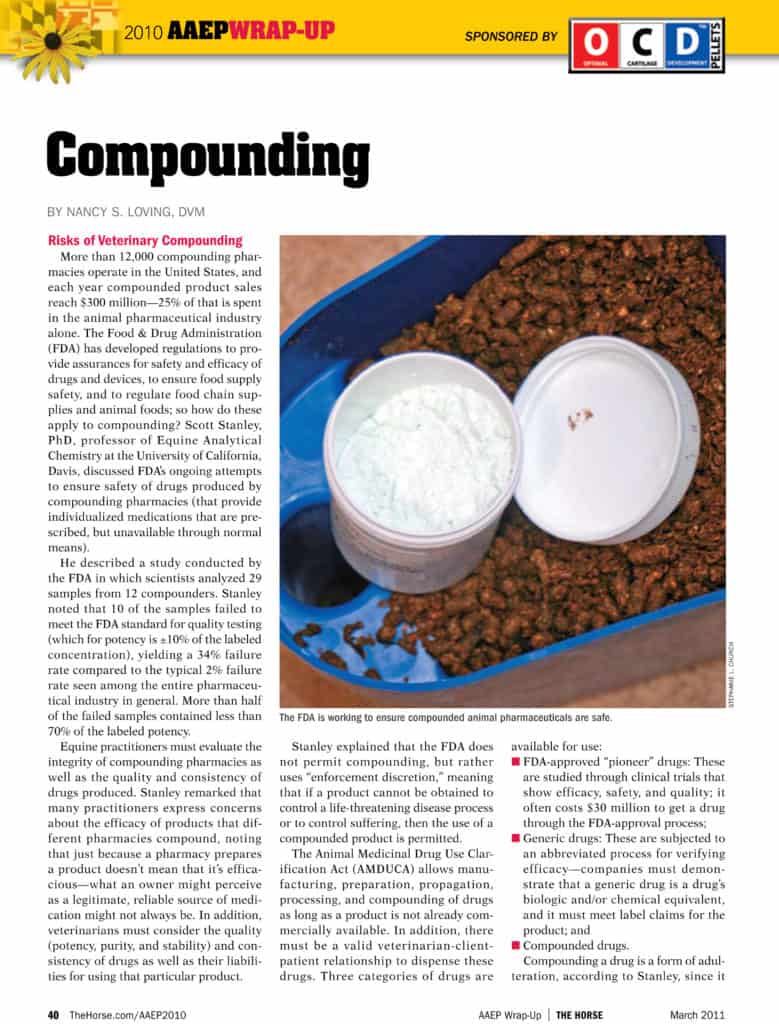Antibiotic Resistance in Horses: Is There a Problem?
Antimicrobial resistance is taking its toll on horses worldwide.
Antimicrobial resistance is taking its toll on horses worldwide.
When was the last time you purged your medicine cabinet?

Compounded or customized medications fulfill a critically important role in horse health care; however, these tailored medications aren’t always what compounders claim them to be, and some are illegal.
Learn about legal and ethical issues with compounded medications for horses in a free TheHorse.com webinar!
The Kentucky Equine Drug Research Council (KEDRC), citing its statutory mission, will be involved in the horse
The University of Kentucky Veterinary Diagnostic Laboratory (UKVDL) recently announced the availability of a
The Federation Equestre Internationale (FEI) has announced detection times for meloxicam (Metacam), a non-steroidal anti-inflammatory drug (NSAID) used to relieve pain and inflammation in the equine athlete.

Regular application of a topical ointment might help horses suffering from insect bite hypersensitivity.
A study showed that oral detomidine gel successfully sedated horses for routine procedures.
Methods of managing pain in horses range from non-steroidal anti-inflammatory drug use and opioids to alpha-2 agonists and ketamine, among others. Over the years, experience and research have helped veterinarians determine which of these are most
The idea of being able to “unsedate” or “reverse” a sedated horse after minor procedures is a great one, but veterinarians must select their cases carefully and be vigilant about using these drugs properly.

At the 2010 American Association of Equine Practitioners convention, Scott Stanley, PhD, professor of Equine Analytical Chemistry at the University of California, Davis, discussed FDA’s ongoing attempts to ensure safety of drugs produced by compounding pharmacies (that provide individualized medications that are pre-scribed, but unavailable through normal means).

At the 2010 American Association of Equine Practitioners convention, veterinarians discussed continuous pain medication delivery, sedative reversal agents, an oral sedative gel, respiratory support for horses under general anesthesia, anesthetizing donkeys, and anti-inflammatory drug safety.
Veterinarians can reduce a horse’s severe forelimb pain by administering a continuous, low-dose infusion of the local anesthetic bupivacaine, but this method is not suitable for every case, according to researchers from Cornell University’s College
Veterinarians commonly treat many equine infections with antimicrobial drugs to achieve resolution. However, in some cases, the antimicrobials themselves induce gastrointestinal disturbances with subsequent diarrhea. “This unfortunate side effect of
The non-steroidal anti-inflammatory drug (NSAID) firocoxib had fewer side effects than phenylbutazone in horses after 42 days of treatment, according to scientists from Merial Limited who presented comparative research results at the 2010 Convention
Stay on top of the most recent Horse Health news with
"*" indicates required fields